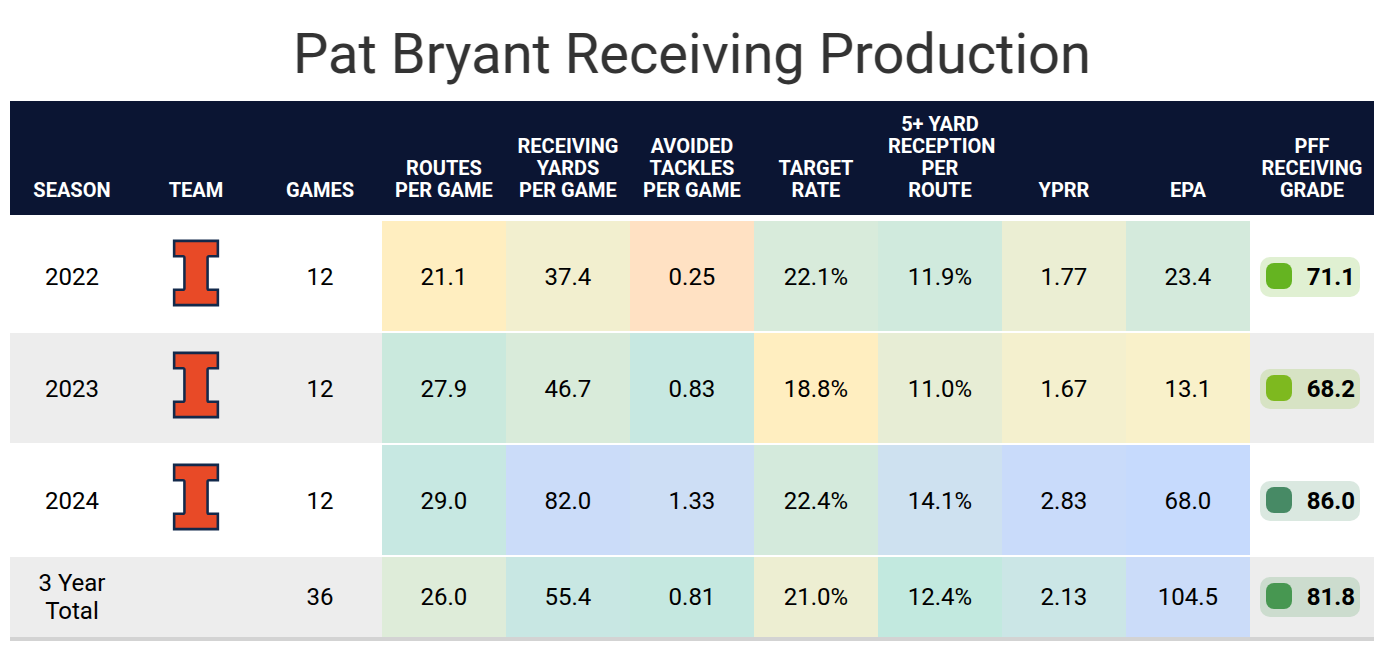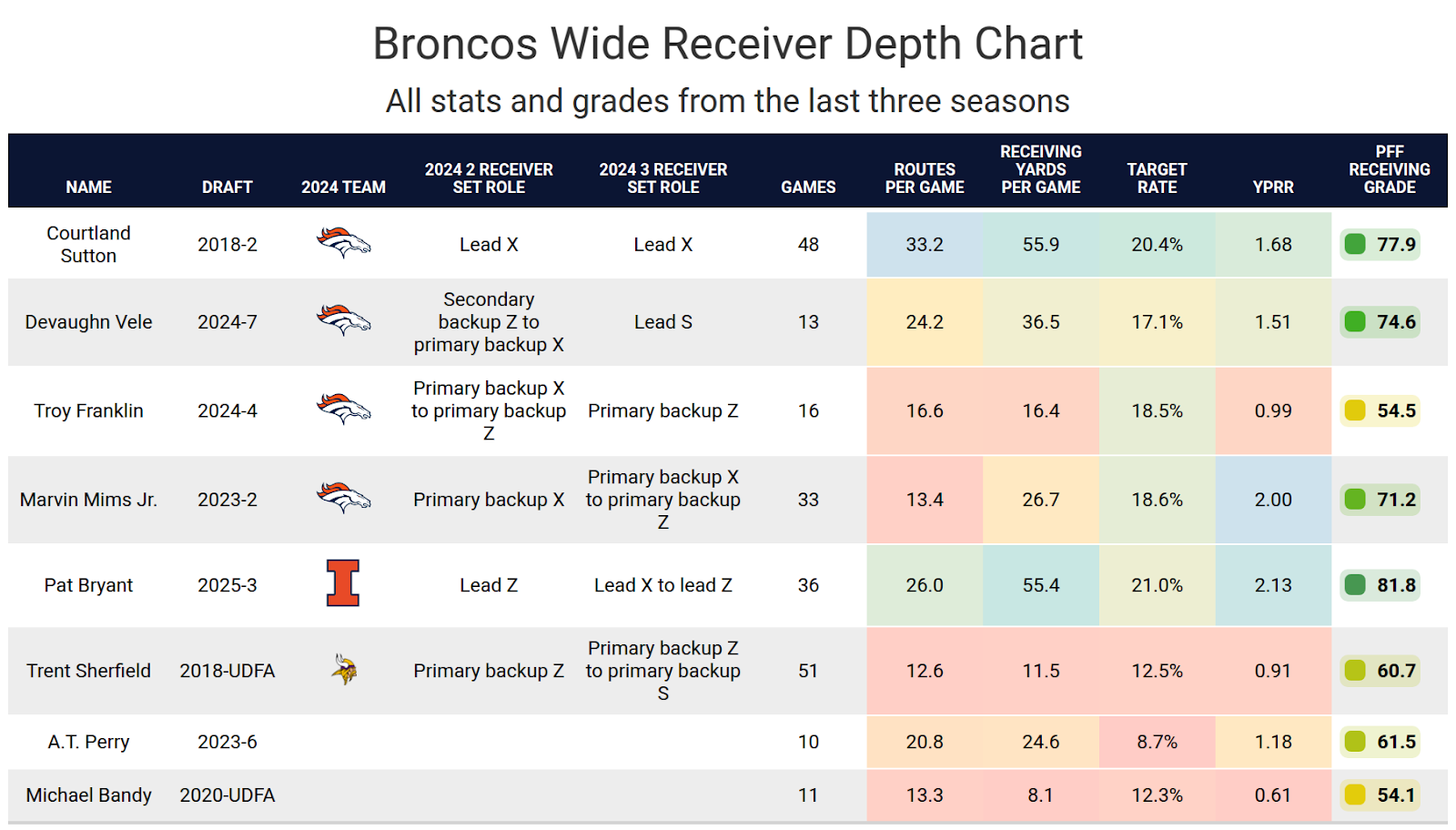- Pat Bryant impressed in his final collegiate season: Bryant had the best receiving season by an Illinois receiver for as long as PFF has been tracking college football.
- Bryant joins a crowded Denver Broncos receiving room: Denver had an apparent wide receiver rotation last season and appeared ready to run it back this season. Bryant was selected 74th overall by Denver, which will lead to even more competition.
- Final chance to claim 25% off PFF+: Use code DRAFT25 and unlock access to player grades, fantasy tools and the 2025 Draft Guide.
Estimated Reading Time: 5 minutes

PFF’s Fantasy Football Player Profile series delivers the most in-depth fantasy football analysis available for the 2025 season.
Using PFF’s exclusive data, we evaluate player performance, competition for touches and how teammates and coaching staffs will impact each player's fantasy football outlook.
Last updated: 7:15 a.m. Friday, May 2
Click here for more draft tools:
NFL Draft Big Board | Mock Draft Simulator | NCAA Premium Stats
2025 PFF Draft Guide | Mock Draft Hub | Prospect Data Profiles
Draft Position Rankings
Player performance
Pat Bryant spent his four-year collegiate career at Illinois, working his way up the wide receiver depth chart. In 2023, he was the clear third wide receiver on the depth chart, playing behind Isaiah Williams and Casey Washington, who both worked their way onto NFL rosters in 2024. Without them, he landed at the top of the depth chart in 2024. His 86.0 receiving grade was the best for an Illinois wide receiver in a season in PFF’s history.
His target rate remained relatively low for a clear top receiver, but that didn’t stop him from posting 2.83 yards per route run. Bryant measured at 6-foot-2 and 204 pounds at the combine. His situational stats suggest he’d be an X receiver in the NFL. He ran nearly 80% of his routes out wide, and he played better as an outside receiver. He similarly played better against man coverage, and his best route was the go route.
Our draft guide agreed, also noting he “lacks separation against single coverage”, which is a common weakness for X receivers. It also made multiple comments praising his blocking. Bryant, Jack Bech and Jackson Meeks were the only Power-Four wide receivers last season with a PFF receiving grade above 78.0 and run-blocking grade above 70.0.


Projected role
Bryant joins a crowded wide receiver room in Denver. Courtland Sutton was the X receiver, while Devaughn Vele was in the slot. Lil’Jordan Humphrey was the Z receiver on early downs, while Troy Franklin and Marvin Mims shared time on later downs. The Broncos opted not to re-sign Humphrey, but instead signed journeymen wide receiver Trent Sherfield. Both rank among the top-12 wide receivers in run-blocking grade over the past three seasons among those who ran at least 1,000 routes, so Sherfield appeared to be a direct replacement for Humphrey.
While Bryant’s size and skill set suggest he should be an X receiver, the Broncos have had no problem putting taller wide receivers in different positions. Denver gave 136 targets to wide receivers 6-foot-4 or taller while they lined up off the line of scrimmage. Only two other teams finished above 65, and the league average was 22. This makes Bryant on the short side for a Broncos wide receiver.
It’s possible that Bryant could be Sutton’s backup or compete with Sherfield for early-down snaps thanks to his blocking ability. It’s entirely possible he can overtake Franklin on the depth chart and be part of the wide receiver rotation on usual passing downs.
Bryant is similar to Tetairoa McMillan and Matthew Golden in that if he exceeds expectations, he could become the top wide receiver on his team’s depth chart as a rookie. Everyone on the depth chart has been a role player outside of Sutton, yet Sutton’s grades indicate he is better suited as a No. 2 option rather than the No. 1. There are a lot of scenarios where Bryant is just a rotational player, while Sutton is the only one with fantasy value. Still, the higher-end scenarios for Bryant are better than the higher-end scenarios for other wide receivers who were also drafted in the third round.


Impact of teammates
Bryant joins Sean Payton with the Broncos, where Payton has an extensive history of rotating wide receivers more than most. Courtland Sutton is the only wide receiver who played more than 700 snaps in a season since Payton became head coach of the Broncos. With the New Orleans Saints, the second wide receiver averaged 648 snaps per season. The only time two wide receivers earned over 800 snaps was in 2016 with Michael Thomas and Brandin Cooks. Last season, 12 teams had two wide receivers with over 800, including the Atlanta Falcons and Chicago Bears, who had three. This means Bryant will likely need to surpass Sutton on the depth chart at some point to be fantasy-relevant.
The good news is that if he can overtake Sutton, he would get paired with quarterback Bo Nix for the foreseeable future. Nix’s 72.8 passing grade ranks seventh-best among rookie quarterbacks of the past decade among those with at least 500 dropbacks. Nix had above-average accuracy, which should help Bryant, who will need accurate passes if he’s not getting much separation.


Bottom line
Bryant’s most likely scenario is that he joins a crowded Broncos wide receiver room and takes part in a heavy rotation that Sean Payton is known for. However, Payton’s top wide receiver tends to have a lot of fantasy value, and it’s at least possible that Bryant can eventually overtake Sutton as Denver’s top receiver.
Footnotes
- Statistics in tables and charts were chosen based on their ability to predict future fantasy performance on a per-game or per-opportunity basis or to describe the player relative to others at the same position.
- “Opportunities” are defined as passing dropbacks, rushing attempts and routes run as a receiver.
- Numbers are provided either by season or based on the past three years. For rookies, only college statistics are included. For non-rookies, only NFL statistics are considered, regardless of whether they played in college within the previous three years.
- As college competition is easier than NFL competition, most rookies are likely to see a decline from their historical numbers.
- Only FBS data is considered for college players and comparisons.
- Kneel-downs are removed from rushing data to provide cleaner quarterback rushing rate statistics.
- The table colors in this article range from blue (indicating good/high) to red (indicating bad/low).
- All percentiles and color codings compare the given player to others with a high sample of opportunities. Generally, the cutoff is one-third of the possible opportunities in the sample. If a player does not meet the threshold, they are still included in the comparison, though their results may appear better or worse than expected due to the smaller, less predictive sample size.
- Information on utilization classifications and their importance can be found here for running backs, wide receivers and tight ends.



 © 2025 PFF - all rights reserved.
© 2025 PFF - all rights reserved.